Kathleen Jones's Blog, page 37
November 9, 2014
Environmental disaster in Italy
Just emerging from the fog of jet-lag after the long flight back from New Zealand via Singapore. I hadn't even managed to unpack my suitcases when a friend, laden with shopping bags of bottled water, told us the unwelcome news that our water supply was contaminated with a poisonous - and possibly radioactive - substance called Thallium. Out for a pizza, since there wasn't anything in the cupboard and I was too woozy to cook anyway, we had missed the police touring the streets the previous evening with loud-hailers as well as the television warnings.

But it's all on the internet. Thallium is used as a rat poison - and also extensively in mining and industrial processes. Here, in Pietrasanta, we're directly below some of the marble 'caves' and quarries. The water, which we believed was pure - and tastes beautiful - comes down from the mountains. Many of the 'caves' have big tailing ponds outside, so there's some local speculation that the recent catastrophic floods caused by extreme rainfall on Wednesday have caused contamination of the aquifers that supply drinking water. But it may be something else entirely. No-one knows.

 Most of Carrara was underwater after 6 inches of rain fell in few hours.What's even more worrying is that the contamination was apparently first revealed by a private individual who (for reasons we don't know) paid to have his water tested and then blew the whistle. Who knows how long we've been drinking poisoned water?
Most of Carrara was underwater after 6 inches of rain fell in few hours.What's even more worrying is that the contamination was apparently first revealed by a private individual who (for reasons we don't know) paid to have his water tested and then blew the whistle. Who knows how long we've been drinking poisoned water?
So now we're forbidden to drink it, told not to use it in food preparation or cooking and advised not even to brush our teeth with it! Water dowsers are being parked up in the piazzas and other public places and we have to fill containers from them. Restaurants and bars have big problems.
 Retained water, outside a quarry in the Alpi Apuane, used in the marble cutting process.
Retained water, outside a quarry in the Alpi Apuane, used in the marble cutting process.
 Quarrying on Mount AltissimoIf the source of the pollution proves to be the mining industry it will certainly add to the big campaign here to stop the destruction of the Alpi Apuani by extensive marble quarrying. The mountains are being mined from within and also from the summit down, as in the picture above, where Mount Altissimo is being taken down block by block. But this is all speculation at the moment and we may never know where the contamination came from.
Quarrying on Mount AltissimoIf the source of the pollution proves to be the mining industry it will certainly add to the big campaign here to stop the destruction of the Alpi Apuani by extensive marble quarrying. The mountains are being mined from within and also from the summit down, as in the picture above, where Mount Altissimo is being taken down block by block. But this is all speculation at the moment and we may never know where the contamination came from.
 Carrara and the Mediterranean from the quarried out Alpi ApuaneThis is such a beautiful place, but it just illustrates what damage human activity is doing to the planet - poisoning the eco-sytem that supports us. The water problem will cost a great deal of money to put right, which will probably in the end have to be funded by the Italian people, not the water company that supplies it. Italy is in deep economic trouble already. There were
demonstrations in Viareggio
yesterday against hikes in nursery fees, school buses and school meals; demonstrations in Carrara (which was devastated by the recent 'bomba d'aqua') against the lack of action in providing flood defences.
Carrara and the Mediterranean from the quarried out Alpi ApuaneThis is such a beautiful place, but it just illustrates what damage human activity is doing to the planet - poisoning the eco-sytem that supports us. The water problem will cost a great deal of money to put right, which will probably in the end have to be funded by the Italian people, not the water company that supplies it. Italy is in deep economic trouble already. There were
demonstrations in Viareggio
yesterday against hikes in nursery fees, school buses and school meals; demonstrations in Carrara (which was devastated by the recent 'bomba d'aqua') against the lack of action in providing flood defences.
 ViareggioI'm flying back to northern England tomorrow (brrrrrrrr......) leaving behind a difficult situation - but at least I'll be able to drink the water. Though recent revelations leaked to the press about the state of the Sellafield
Nuclear Processing Plant's containment tanks
make me worry that the pristine environment of Cumbria's Lake District could soon be compromised. Human beings simply can't be trusted with dangerous chemicals.
ViareggioI'm flying back to northern England tomorrow (brrrrrrrr......) leaving behind a difficult situation - but at least I'll be able to drink the water. Though recent revelations leaked to the press about the state of the Sellafield
Nuclear Processing Plant's containment tanks
make me worry that the pristine environment of Cumbria's Lake District could soon be compromised. Human beings simply can't be trusted with dangerous chemicals.

But it's all on the internet. Thallium is used as a rat poison - and also extensively in mining and industrial processes. Here, in Pietrasanta, we're directly below some of the marble 'caves' and quarries. The water, which we believed was pure - and tastes beautiful - comes down from the mountains. Many of the 'caves' have big tailing ponds outside, so there's some local speculation that the recent catastrophic floods caused by extreme rainfall on Wednesday have caused contamination of the aquifers that supply drinking water. But it may be something else entirely. No-one knows.

 Most of Carrara was underwater after 6 inches of rain fell in few hours.What's even more worrying is that the contamination was apparently first revealed by a private individual who (for reasons we don't know) paid to have his water tested and then blew the whistle. Who knows how long we've been drinking poisoned water?
Most of Carrara was underwater after 6 inches of rain fell in few hours.What's even more worrying is that the contamination was apparently first revealed by a private individual who (for reasons we don't know) paid to have his water tested and then blew the whistle. Who knows how long we've been drinking poisoned water?So now we're forbidden to drink it, told not to use it in food preparation or cooking and advised not even to brush our teeth with it! Water dowsers are being parked up in the piazzas and other public places and we have to fill containers from them. Restaurants and bars have big problems.
 Retained water, outside a quarry in the Alpi Apuane, used in the marble cutting process.
Retained water, outside a quarry in the Alpi Apuane, used in the marble cutting process.
 Quarrying on Mount AltissimoIf the source of the pollution proves to be the mining industry it will certainly add to the big campaign here to stop the destruction of the Alpi Apuani by extensive marble quarrying. The mountains are being mined from within and also from the summit down, as in the picture above, where Mount Altissimo is being taken down block by block. But this is all speculation at the moment and we may never know where the contamination came from.
Quarrying on Mount AltissimoIf the source of the pollution proves to be the mining industry it will certainly add to the big campaign here to stop the destruction of the Alpi Apuani by extensive marble quarrying. The mountains are being mined from within and also from the summit down, as in the picture above, where Mount Altissimo is being taken down block by block. But this is all speculation at the moment and we may never know where the contamination came from. Carrara and the Mediterranean from the quarried out Alpi ApuaneThis is such a beautiful place, but it just illustrates what damage human activity is doing to the planet - poisoning the eco-sytem that supports us. The water problem will cost a great deal of money to put right, which will probably in the end have to be funded by the Italian people, not the water company that supplies it. Italy is in deep economic trouble already. There were
demonstrations in Viareggio
yesterday against hikes in nursery fees, school buses and school meals; demonstrations in Carrara (which was devastated by the recent 'bomba d'aqua') against the lack of action in providing flood defences.
Carrara and the Mediterranean from the quarried out Alpi ApuaneThis is such a beautiful place, but it just illustrates what damage human activity is doing to the planet - poisoning the eco-sytem that supports us. The water problem will cost a great deal of money to put right, which will probably in the end have to be funded by the Italian people, not the water company that supplies it. Italy is in deep economic trouble already. There were
demonstrations in Viareggio
yesterday against hikes in nursery fees, school buses and school meals; demonstrations in Carrara (which was devastated by the recent 'bomba d'aqua') against the lack of action in providing flood defences. ViareggioI'm flying back to northern England tomorrow (brrrrrrrr......) leaving behind a difficult situation - but at least I'll be able to drink the water. Though recent revelations leaked to the press about the state of the Sellafield
Nuclear Processing Plant's containment tanks
make me worry that the pristine environment of Cumbria's Lake District could soon be compromised. Human beings simply can't be trusted with dangerous chemicals.
ViareggioI'm flying back to northern England tomorrow (brrrrrrrr......) leaving behind a difficult situation - but at least I'll be able to drink the water. Though recent revelations leaked to the press about the state of the Sellafield
Nuclear Processing Plant's containment tanks
make me worry that the pristine environment of Cumbria's Lake District could soon be compromised. Human beings simply can't be trusted with dangerous chemicals.
Published on November 09, 2014 00:11
November 7, 2014
Making a House of Words - Writers in Exile
I'm reblogging my post for Authors Electric, two days ago, on the mixed feelings I have when travelling - the conflict between longing and belonging. It's a problem for a lot of writers, but it's produced some fine writing.
“I’m in New Zealand at the moment visiting relatives and friends and re-visiting much loved locations. It's a weird sensation being in a place where I've spent so much time over the years, but yet can never properly belong. There's a sense of both homecoming and exile.
 Janet FrameJanet Frame, one of New Zealand’s best-known writers, wrote that ‘All writers are exiles wherever they live . . . and their work is a lifelong journey towards the lost land.’*1 Perhaps this is because, as writers, we have to stand outside our own experience and look at it objectively in order to write about it. We're always trying to get back to the 'lost land', those moments experienced and gone, at the core of our imaginative lives.
Janet FrameJanet Frame, one of New Zealand’s best-known writers, wrote that ‘All writers are exiles wherever they live . . . and their work is a lifelong journey towards the lost land.’*1 Perhaps this is because, as writers, we have to stand outside our own experience and look at it objectively in order to write about it. We're always trying to get back to the 'lost land', those moments experienced and gone, at the core of our imaginative lives.

But many of us are also physical exiles. Few people live in the place where they were brought up and the moment you move away from your native territory and look at it from the outside things will never be the same again. Your mind is always in two places at any one time. The writer Edward Said - born in Palestine and an exile since 1947 - wrote that what we do as writers is ‘by necessity’, to make ourselves ‘a house of words’ to dwell in.*2
This is what the New Zealand writer Katherine Mansfield did when she emigrated to Europe at 18 leaving Wellington behind. She couldn’t wait to leave such a dull, parochial place, but spent her whole writing life trying to recreate it.
 Katherine Mansfield, writing at Menton‘What is it that I do want to write?’ she asked her journal while living in France. And the answer was New Zealand. ‘Now, I want to write recollections of my own country. . . I want . . . to make our undiscovered country leap into the eyes of the old world.’ Her New Zealand stories, Prelude, At the Bay, The Dolls House, are among the best short stories ever written.*3
Katherine Mansfield, writing at Menton‘What is it that I do want to write?’ she asked her journal while living in France. And the answer was New Zealand. ‘Now, I want to write recollections of my own country. . . I want . . . to make our undiscovered country leap into the eyes of the old world.’ Her New Zealand stories, Prelude, At the Bay, The Dolls House, are among the best short stories ever written.*3

Later, when she was dying of TB in her early thirties she decided that it did a writer no good to be transplanted. Roots, she declared, were vitally important to the depth of our writing. If we can't connect with them, ‘One reaps the glittering top of the field, but there are no sheaves to bind.’
Since I left my home in Northern England as a teenager, it’s a question I’ve spent a life-time trying to answer. I’ve scribbled in the damp heat of an African rainy season, the scorching blast of a middle-eastern summer, snow in Scotland, 24 hour daylight in Russia, a rocky sea-shore in western Australia, monsoon in India, trains and ships and planes, an olive grove in Tuscany and currently the windy, cloudy, upside-down plains of southern New Zealand.
Wittgenstein wrote that our most powerful and formative experiences are those of our early years - the primal imprints of the landscape and social networks of our childhood. These shape our imaginations for the whole of our adult lives. So my roots are firmly struck in the Cumbrian fells. But I’ve spent my life as a nomad, travelling and living all over the world, gazing nostalgically back.
 I recently wrote the biography of a northern poet called Norman Nicholson, born and brought up in Cumbria, who lived until he died in the same house he’d been born in.*4 Would he have been a better writer if he had moved away and gained experience and perspective? My personal opinion was that he would. There’s something about being able to stand outside and look in. But Norman felt that his small town was a microcosm of the world and that he would have gained nothing if he’d lived elsewhere. A difficult one to argue. The Irish poet Patrick Kavanagh wrote that it took a lifetime to know just one small acre of the planet and that for a poet it was depth that mattered.
I recently wrote the biography of a northern poet called Norman Nicholson, born and brought up in Cumbria, who lived until he died in the same house he’d been born in.*4 Would he have been a better writer if he had moved away and gained experience and perspective? My personal opinion was that he would. There’s something about being able to stand outside and look in. But Norman felt that his small town was a microcosm of the world and that he would have gained nothing if he’d lived elsewhere. A difficult one to argue. The Irish poet Patrick Kavanagh wrote that it took a lifetime to know just one small acre of the planet and that for a poet it was depth that mattered.
When you begin to think about it, there are an enormous number of writers who wrote in exile. Ernest Hemingway, James Joyce, Henry James, Edith Wharton, Edna O’Brien, Katherine Mansfield, Ian Fleming, T.S. Eliot, Sylvia Plath, Jean Rhys, W.G. Sebald, Muriel Spark, F. Scott Fitzgerald . . . The list is endless. So perhaps travel does, indeed, expand the mind and stimulate the creative juices.
I haven’t yet, apart from the Katherine Mansfield biography, written more than the odd poem about New Zealand, but something is beginning to shape itself into words - slowly, tentatively. So, who knows? I may come back with something more than Whittaker’s chocolate and some beautiful photographs. As you read this, I will be somewhere in the air over Singapore returning to Italy, en route for England, where I've just accepted another appointment as RLF Fellow in the Creative Writing Dept of Lancaster University. Another move across Europe, yet another re-location. The Philosopher Paul Carter wrote in Living in a New Country that, 'once the process of emigration has started, there can be no settling'*5, so it seems that all I will ever have is whatever house of words I can construct for myself."
*1 Janet Frame: An Envoy from Mirror City
*2 Edward Said: Out of Place
*3 Katherine Mansfield - The Storyteller
*4 Norman Nicholson: The Whispering Poet
*5 Quoted by Kirsty Gunn in Thorndon (another excellent book about belonging)
“I’m in New Zealand at the moment visiting relatives and friends and re-visiting much loved locations. It's a weird sensation being in a place where I've spent so much time over the years, but yet can never properly belong. There's a sense of both homecoming and exile.
 Janet FrameJanet Frame, one of New Zealand’s best-known writers, wrote that ‘All writers are exiles wherever they live . . . and their work is a lifelong journey towards the lost land.’*1 Perhaps this is because, as writers, we have to stand outside our own experience and look at it objectively in order to write about it. We're always trying to get back to the 'lost land', those moments experienced and gone, at the core of our imaginative lives.
Janet FrameJanet Frame, one of New Zealand’s best-known writers, wrote that ‘All writers are exiles wherever they live . . . and their work is a lifelong journey towards the lost land.’*1 Perhaps this is because, as writers, we have to stand outside our own experience and look at it objectively in order to write about it. We're always trying to get back to the 'lost land', those moments experienced and gone, at the core of our imaginative lives.
But many of us are also physical exiles. Few people live in the place where they were brought up and the moment you move away from your native territory and look at it from the outside things will never be the same again. Your mind is always in two places at any one time. The writer Edward Said - born in Palestine and an exile since 1947 - wrote that what we do as writers is ‘by necessity’, to make ourselves ‘a house of words’ to dwell in.*2
This is what the New Zealand writer Katherine Mansfield did when she emigrated to Europe at 18 leaving Wellington behind. She couldn’t wait to leave such a dull, parochial place, but spent her whole writing life trying to recreate it.
 Katherine Mansfield, writing at Menton‘What is it that I do want to write?’ she asked her journal while living in France. And the answer was New Zealand. ‘Now, I want to write recollections of my own country. . . I want . . . to make our undiscovered country leap into the eyes of the old world.’ Her New Zealand stories, Prelude, At the Bay, The Dolls House, are among the best short stories ever written.*3
Katherine Mansfield, writing at Menton‘What is it that I do want to write?’ she asked her journal while living in France. And the answer was New Zealand. ‘Now, I want to write recollections of my own country. . . I want . . . to make our undiscovered country leap into the eyes of the old world.’ Her New Zealand stories, Prelude, At the Bay, The Dolls House, are among the best short stories ever written.*3
Later, when she was dying of TB in her early thirties she decided that it did a writer no good to be transplanted. Roots, she declared, were vitally important to the depth of our writing. If we can't connect with them, ‘One reaps the glittering top of the field, but there are no sheaves to bind.’
Since I left my home in Northern England as a teenager, it’s a question I’ve spent a life-time trying to answer. I’ve scribbled in the damp heat of an African rainy season, the scorching blast of a middle-eastern summer, snow in Scotland, 24 hour daylight in Russia, a rocky sea-shore in western Australia, monsoon in India, trains and ships and planes, an olive grove in Tuscany and currently the windy, cloudy, upside-down plains of southern New Zealand.
Wittgenstein wrote that our most powerful and formative experiences are those of our early years - the primal imprints of the landscape and social networks of our childhood. These shape our imaginations for the whole of our adult lives. So my roots are firmly struck in the Cumbrian fells. But I’ve spent my life as a nomad, travelling and living all over the world, gazing nostalgically back.
 I recently wrote the biography of a northern poet called Norman Nicholson, born and brought up in Cumbria, who lived until he died in the same house he’d been born in.*4 Would he have been a better writer if he had moved away and gained experience and perspective? My personal opinion was that he would. There’s something about being able to stand outside and look in. But Norman felt that his small town was a microcosm of the world and that he would have gained nothing if he’d lived elsewhere. A difficult one to argue. The Irish poet Patrick Kavanagh wrote that it took a lifetime to know just one small acre of the planet and that for a poet it was depth that mattered.
I recently wrote the biography of a northern poet called Norman Nicholson, born and brought up in Cumbria, who lived until he died in the same house he’d been born in.*4 Would he have been a better writer if he had moved away and gained experience and perspective? My personal opinion was that he would. There’s something about being able to stand outside and look in. But Norman felt that his small town was a microcosm of the world and that he would have gained nothing if he’d lived elsewhere. A difficult one to argue. The Irish poet Patrick Kavanagh wrote that it took a lifetime to know just one small acre of the planet and that for a poet it was depth that mattered.When you begin to think about it, there are an enormous number of writers who wrote in exile. Ernest Hemingway, James Joyce, Henry James, Edith Wharton, Edna O’Brien, Katherine Mansfield, Ian Fleming, T.S. Eliot, Sylvia Plath, Jean Rhys, W.G. Sebald, Muriel Spark, F. Scott Fitzgerald . . . The list is endless. So perhaps travel does, indeed, expand the mind and stimulate the creative juices.
I haven’t yet, apart from the Katherine Mansfield biography, written more than the odd poem about New Zealand, but something is beginning to shape itself into words - slowly, tentatively. So, who knows? I may come back with something more than Whittaker’s chocolate and some beautiful photographs. As you read this, I will be somewhere in the air over Singapore returning to Italy, en route for England, where I've just accepted another appointment as RLF Fellow in the Creative Writing Dept of Lancaster University. Another move across Europe, yet another re-location. The Philosopher Paul Carter wrote in Living in a New Country that, 'once the process of emigration has started, there can be no settling'*5, so it seems that all I will ever have is whatever house of words I can construct for myself."
*1 Janet Frame: An Envoy from Mirror City
*2 Edward Said: Out of Place
*3 Katherine Mansfield - The Storyteller
*4 Norman Nicholson: The Whispering Poet
*5 Quoted by Kirsty Gunn in Thorndon (another excellent book about belonging)
Published on November 07, 2014 01:01
November 3, 2014
Tuesday Poem: After Making Love We Hear Footsteps - Galway Kinnell
For I can snore like a bullhorn
or play loud music
or sit up talking with any reasonably sober Irishman
and Fergus will only sink deeper
into his dreamless sleep, which goes by all in one flash,
but let there be that heavy breathing
or a stifled come-cry anywhere in the house
and he will wrench himself awake
and make for it on the run—as now, we lie together,
after making love, quiet, touching along the length of our bodies,
familiar touch of the long-married,
and he appears—in his baseball pajamas, it happens,
the neck opening so small he has to screw them on—
and flops down between us and hugs us and snuggles himself to sleep,
his face gleaming with satisfaction at being this very child.
In the half darkness we look at each other
and smile
and touch arms across this little, startlingly muscled body—
this one whom habit of memory propels to the ground of his making,
sleeper only the mortal sounds can sing awake,
this blessing love gives again into our arms.
Galway Kinnell, “After Making Love We Hear Footsteps” from Three Books.
To read the poem and hear it being read by Galway Kinnell click here
Galway Kinnell - another of those brilliant Irish American poets - has died. He was 87. This is a poem I particularly love.
To see what the other Tuesday Poets are posting, please click over to the Tuesday Poem hub here . . .
or play loud music
or sit up talking with any reasonably sober Irishman
and Fergus will only sink deeper
into his dreamless sleep, which goes by all in one flash,
but let there be that heavy breathing
or a stifled come-cry anywhere in the house
and he will wrench himself awake
and make for it on the run—as now, we lie together,
after making love, quiet, touching along the length of our bodies,
familiar touch of the long-married,
and he appears—in his baseball pajamas, it happens,
the neck opening so small he has to screw them on—
and flops down between us and hugs us and snuggles himself to sleep,
his face gleaming with satisfaction at being this very child.
In the half darkness we look at each other
and smile
and touch arms across this little, startlingly muscled body—
this one whom habit of memory propels to the ground of his making,
sleeper only the mortal sounds can sing awake,
this blessing love gives again into our arms.
Galway Kinnell, “After Making Love We Hear Footsteps” from Three Books.
To read the poem and hear it being read by Galway Kinnell click here
Galway Kinnell - another of those brilliant Irish American poets - has died. He was 87. This is a poem I particularly love.
To see what the other Tuesday Poets are posting, please click over to the Tuesday Poem hub here . . .
Published on November 03, 2014 15:30
November 2, 2014
Christchurch Earthquake - 4 years on
 The old, earthquake damaged, and the newIt's four years almost exactly since I came to Christchurch to take part in the Literature Festival and found myself in the middle of a 7.2 earthquake - experiencing weeks of aftershocks and witnessing the fracturing of a city. A few months later, a particularly shallow magnitude 6 brought down many of the remaining buildings and killed a significant number of people. The city centre was destroyed.
The old, earthquake damaged, and the newIt's four years almost exactly since I came to Christchurch to take part in the Literature Festival and found myself in the middle of a 7.2 earthquake - experiencing weeks of aftershocks and witnessing the fracturing of a city. A few months later, a particularly shallow magnitude 6 brought down many of the remaining buildings and killed a significant number of people. The city centre was destroyed. One of my 2010 photosOn my last visit, the city centre was a demolition site - cordoned off from the public - a landscape of skewed and damaged buildings waiting to be turned to rubble. So I was curious to see what had happened since then.
One of my 2010 photosOn my last visit, the city centre was a demolition site - cordoned off from the public - a landscape of skewed and damaged buildings waiting to be turned to rubble. So I was curious to see what had happened since then. Christchurch City Centre 2014
Christchurch City Centre 2014Christchurch is a building site now - a developers' paradise. There are cranes everywhere, scaffolding and piling on cleared lots.
 Arts CentreOne thing that troubles me, is the length of time it seems to be taking to restore Heritage buildings. The arts centre is still shrouded in scaffolding, though work does seem to be going on there.
Arts CentreOne thing that troubles me, is the length of time it seems to be taking to restore Heritage buildings. The arts centre is still shrouded in scaffolding, though work does seem to be going on there.
The Cathedral untouched - one end propped up, but no sign of restoration at all.
This is the first time I've managed to get into Christchurch since I arrived four weeks ago. It will be interesting to see what it looks like next time I come here.
Published on November 02, 2014 02:16
October 31, 2014
Whale watching in Kaikoura
When I left Wellington I headed south for Kaikoura which, for me, is one of the most beautiful places in the world.

The snow-capped mountains around the bay and the ocean that never seems to be out of view have a calming effect guaranteed to cure the worst cases of stress.

I walked, went rock-pooling, sat around just looking at the sea, tripped over the occasional seal and - on one cold afternoon - went to the tiny local art-deco cinema that holds about 30 people and watched Pride. There were only four people in the audience, but it didn't matter.

Most people in Kaikoura want to interact with the wild-life, either the seals on the shore or the whales that feed in the deep ocean trenches just off shore. I went out on the whale boat with my grandchildren, but I've become increasingly uneasy about the whole process. We were one of two boats tracking the whales, plus a helicopter and a spotter plane. What does this do to these animals?
 Using hydrophones to find the whalesYou don't have to go out on the whale boats to see the sea-life; you just have to get lucky. When we were standing on the wharf in Kaikoura bay before leaving, a humpback whale suddenly heaved itself up out of the water, rolling lazily around - a whale we didn't have to pay to see. One who didn't stay to be photographed!
Using hydrophones to find the whalesYou don't have to go out on the whale boats to see the sea-life; you just have to get lucky. When we were standing on the wharf in Kaikoura bay before leaving, a humpback whale suddenly heaved itself up out of the water, rolling lazily around - a whale we didn't have to pay to see. One who didn't stay to be photographed!
Kaikoura is a town built on whale bone - literally. One of the oldest buildings, built by George Fyffe - a whaler and one of the original settlers - is built on whales' vertebrae. The fences were also built of whale bone.
 A whale's vertebra in the foundations.
A whale's vertebra in the foundations.
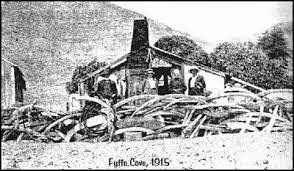 The old whale-bone fencesNow the town makes a living from eco-tourism. People come from all over the world to swim with dolphins and get within shouting distance of a whale.
The old whale-bone fencesNow the town makes a living from eco-tourism. People come from all over the world to swim with dolphins and get within shouting distance of a whale.
New Zealand goes to great lengths to preserve its pristine environment (biological customs at the airport is an experience!), but it's not immune to what is happening in the world due to climate change. On the road we passed long acres of dead and dying trees - not a natural phenomenon. And, further south, we stopped for lunch at St Anne's Lagoon, where there were huge notices warning of toxic algae. We were not to go anywhere near the water or handle anything that had been in it.
 The road from Blenheim to KaikouraI'm now back in Lincoln (on the Canterbury plain not far from Christchurch) and time is running out before I have to go back to the UK and I haven't done half the things I intended to do when I came here. But it doesn't matter. Sometimes you just have to sit back and let time flow.
The road from Blenheim to KaikouraI'm now back in Lincoln (on the Canterbury plain not far from Christchurch) and time is running out before I have to go back to the UK and I haven't done half the things I intended to do when I came here. But it doesn't matter. Sometimes you just have to sit back and let time flow.

The snow-capped mountains around the bay and the ocean that never seems to be out of view have a calming effect guaranteed to cure the worst cases of stress.

I walked, went rock-pooling, sat around just looking at the sea, tripped over the occasional seal and - on one cold afternoon - went to the tiny local art-deco cinema that holds about 30 people and watched Pride. There were only four people in the audience, but it didn't matter.

Most people in Kaikoura want to interact with the wild-life, either the seals on the shore or the whales that feed in the deep ocean trenches just off shore. I went out on the whale boat with my grandchildren, but I've become increasingly uneasy about the whole process. We were one of two boats tracking the whales, plus a helicopter and a spotter plane. What does this do to these animals?
 Using hydrophones to find the whalesYou don't have to go out on the whale boats to see the sea-life; you just have to get lucky. When we were standing on the wharf in Kaikoura bay before leaving, a humpback whale suddenly heaved itself up out of the water, rolling lazily around - a whale we didn't have to pay to see. One who didn't stay to be photographed!
Using hydrophones to find the whalesYou don't have to go out on the whale boats to see the sea-life; you just have to get lucky. When we were standing on the wharf in Kaikoura bay before leaving, a humpback whale suddenly heaved itself up out of the water, rolling lazily around - a whale we didn't have to pay to see. One who didn't stay to be photographed!Kaikoura is a town built on whale bone - literally. One of the oldest buildings, built by George Fyffe - a whaler and one of the original settlers - is built on whales' vertebrae. The fences were also built of whale bone.
 A whale's vertebra in the foundations.
A whale's vertebra in the foundations. The old whale-bone fencesNow the town makes a living from eco-tourism. People come from all over the world to swim with dolphins and get within shouting distance of a whale.
The old whale-bone fencesNow the town makes a living from eco-tourism. People come from all over the world to swim with dolphins and get within shouting distance of a whale.New Zealand goes to great lengths to preserve its pristine environment (biological customs at the airport is an experience!), but it's not immune to what is happening in the world due to climate change. On the road we passed long acres of dead and dying trees - not a natural phenomenon. And, further south, we stopped for lunch at St Anne's Lagoon, where there were huge notices warning of toxic algae. We were not to go anywhere near the water or handle anything that had been in it.
 The road from Blenheim to KaikouraI'm now back in Lincoln (on the Canterbury plain not far from Christchurch) and time is running out before I have to go back to the UK and I haven't done half the things I intended to do when I came here. But it doesn't matter. Sometimes you just have to sit back and let time flow.
The road from Blenheim to KaikouraI'm now back in Lincoln (on the Canterbury plain not far from Christchurch) and time is running out before I have to go back to the UK and I haven't done half the things I intended to do when I came here. But it doesn't matter. Sometimes you just have to sit back and let time flow.
Published on October 31, 2014 00:33
October 27, 2014
Tuesday Poem: Belonging
Wellington harbour 2014
I am no more at home here
than the sea gull
visiting the old wharf outside the bar.
But the hills
around the bay lift my heart
and the dry
Marlborough wine tastes clean
on my tongue.
And I could sit forever here
watching the wind
capture the waves and toss
seabirds above
the tilting horizon.
Where is it?
This thing called home. The destination port
we’re all aiming for.
Salmon scent the water that spawned them;
migrating birds
guided by a compass in the brain.
Not bound by instinct
we can choose where we perch
drawn to a wide sky
a certain line of hills, a street, a field
that has something of ourselves
we recognise, deep as an ocean trench
beyond memory
a homecoming.
© Kathleen Jones
This is still a notebook scribble on my journey through New Zealand. Thinking a lot about travelling and belonging and where exactly 'home' is. It's a bit like that thing called 'beauty' - you know it when you see it. Wellington always feels like home to me.
Why don't you hop over to the Tuesday Poem main hub and see what the other Tuesday Poets are posting today? You'll find it here ......
I am no more at home here
than the sea gull
visiting the old wharf outside the bar.
But the hills
around the bay lift my heart
and the dry
Marlborough wine tastes clean
on my tongue.
And I could sit forever here
watching the wind
capture the waves and toss
seabirds above
the tilting horizon.
Where is it?
This thing called home. The destination port
we’re all aiming for.
Salmon scent the water that spawned them;
migrating birds
guided by a compass in the brain.
Not bound by instinct
we can choose where we perch
drawn to a wide sky
a certain line of hills, a street, a field
that has something of ourselves
we recognise, deep as an ocean trench
beyond memory
a homecoming.
© Kathleen Jones
This is still a notebook scribble on my journey through New Zealand. Thinking a lot about travelling and belonging and where exactly 'home' is. It's a bit like that thing called 'beauty' - you know it when you see it. Wellington always feels like home to me.
Why don't you hop over to the Tuesday Poem main hub and see what the other Tuesday Poets are posting today? You'll find it here ......
Published on October 27, 2014 01:53
October 22, 2014
On the Mansfield Trail
When I come to Wellington there are certain places I always visit - places connected with Katherine Mansfield whose life will always be part of mine now. Not just because I wrote her biography, but that because of Mansfield I have good friends in New Zealand; because of Mansfield I have a daughter and two grandchildren in New Zealand.

This time I wanted to see the new Mansfield sculpture on Lambton Quay created by NZ sculptor Virginia King and unveiled last year. Called ‘Woman of Words’, it’s made of welded metal with sentences from Katherine’s stories and journals incised into it.
 'I'm afraid you do not count - you are just a little savage from New Zealand'.
'I'm afraid you do not count - you are just a little savage from New Zealand'. 'In the evening the cicada shakes his tiny tambourine'.I spent quite a bit of time looking at it, but couldn’t make up my mind what I felt. There’s something robotic about the figure, but there is definitely something that conjures up Mansfield - though rather as an avatar in a computer game. The figure is eye-catching, as Mansfield was herself, and the words are wonderful - they shout ‘Katherine Mansfield’ very loudly to everyone who passes by. So it does the job.
'In the evening the cicada shakes his tiny tambourine'.I spent quite a bit of time looking at it, but couldn’t make up my mind what I felt. There’s something robotic about the figure, but there is definitely something that conjures up Mansfield - though rather as an avatar in a computer game. The figure is eye-catching, as Mansfield was herself, and the words are wonderful - they shout ‘Katherine Mansfield’ very loudly to everyone who passes by. So it does the job.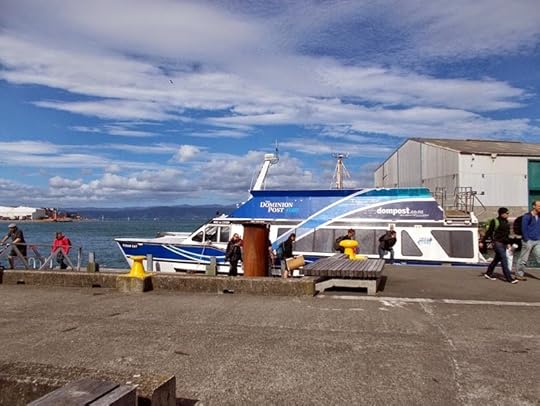
I took the ferry over the harbour to Days Bay to look at the little holiday ‘bach’ where Katherine spent so much of her holiday time as a child and then as a young woman and which features in her diaries and stories, particularly ‘At the Bay’. There were terrible storms last year and the property was so badly damaged it was feared that it might have to be demolished.
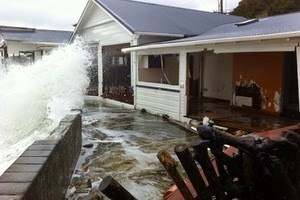 The house is now boarded up.One of the neighbouring houses has been bulldozed and others are empty,
The house is now boarded up.One of the neighbouring houses has been bulldozed and others are empty, For one awful moment, I thought that this was Katherine's Cottagebut I was glad to discover that they hope to restore ‘Katherine’s Cottage’, though it’s still boarded up and I couldn’t get near it to have a proper look. The little house is so near to the sea you can’t help wondering if rising sea levels will make attempts to preserve it futile.
For one awful moment, I thought that this was Katherine's Cottagebut I was glad to discover that they hope to restore ‘Katherine’s Cottage’, though it’s still boarded up and I couldn’t get near it to have a proper look. The little house is so near to the sea you can’t help wondering if rising sea levels will make attempts to preserve it futile.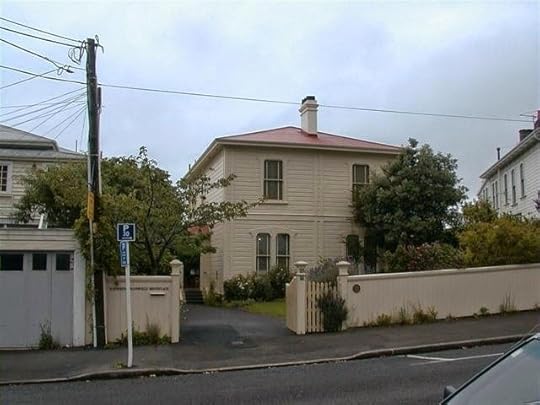 The Birthplace Trust on Tinakori RoadThen I went, as I always do, up to the Katherine Mansfield Birthplace Trust to spend some precious moments in the house where Katherine was born, where NZ writer Kirsty Gunn recently spent time sitting on the stairs imagining her presence, just as I like to do. ‘All it took was for me to sit on the first-floor landing of the house in Tinakori Road, looking up at the high window and be completely alone, it seemed, on a stormy winter’s afternoon, the house hushed around me but for the fierceness of the southerly wind outside rattling at its beams and chimney, beating the flax and pohutukawa trees and manuka bushes with incessant rain . . . And I was there entirely, in a story of my own’.* Stairs, Katherine wrote, were wonderful places to exercise the imagination.
The Birthplace Trust on Tinakori RoadThen I went, as I always do, up to the Katherine Mansfield Birthplace Trust to spend some precious moments in the house where Katherine was born, where NZ writer Kirsty Gunn recently spent time sitting on the stairs imagining her presence, just as I like to do. ‘All it took was for me to sit on the first-floor landing of the house in Tinakori Road, looking up at the high window and be completely alone, it seemed, on a stormy winter’s afternoon, the house hushed around me but for the fierceness of the southerly wind outside rattling at its beams and chimney, beating the flax and pohutukawa trees and manuka bushes with incessant rain . . . And I was there entirely, in a story of my own’.* Stairs, Katherine wrote, were wonderful places to exercise the imagination.
In one of the downstairs rooms is a dolls’ house, placed there to replicate the dolls’ house of Katherine’s childhood - one of her most famous stories and one that came from the deepest, Freudian, recesses of her psyche. You can see the dolls’ house clearly in this photograph of Katherine’s grandmother holding her baby sister, Gwen, recently deceased from Cholera - a baby she coupled in her mind with her own dead baby.
 Granny Dyer, holding Gwen, deceased.The dolls’ house also represented for Katherine the home she never had - the home she yearned for.
Granny Dyer, holding Gwen, deceased.The dolls’ house also represented for Katherine the home she never had - the home she yearned for.Like the child in Katherine's story, after being allowed to view the dolls’ house illicitly, I too have ‘seen the little lamp’, though the photograph came out rather blurry.

In the garden there’s a new memorial to Katherine, donated to the Birthplace Trust. It’s a little static, like a ship’s figurehead, but Helen - who showed me round this time - took my photo beside it and (after several attempts) managed to get one of me without my eyes closed or pulling a face. Anyone who knows me will realise what an achievement that was!

I had a browse through the bookshops and bought Kirsty Gunn’s new book ‘Thorndon’ - a journal of her time at the Randall Cottage Trust exploring her own Wellington roots and her relationship with Katherine Mansfield. I value Kirsty Gunn's writing a lot and have her new book 'Infidelities' on my reading list.
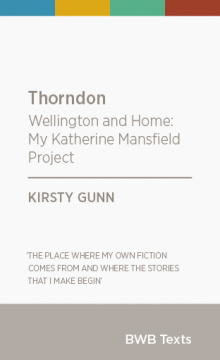
I’ve been reading Thorndon in bed and found a lot of parallels between Kirsty’s experience and my own. There are a great many writers, myself included, who owe a debt to Mansfield’s magic. Wellington is a city that is haunted by her - there is hardly a location that doesn’t have an association with either the writer or her stories. I’m drawn back to it, again and again, always trying to make that elusive connection with a girl who’s been dead for a hundred years.
*Kirsty Gunn ‘Thorndon’ p.85, pub. Bridget Williams Books
Published on October 22, 2014 19:38
October 20, 2014
Booklovers Bed and Breakfast in Wellington
Oh the delights of talking about books over breakfast with someone who cares as passionately about the written word as you do yourself!
I’m in booklovers paradise, staying in Jane Tolerton’s Booklovers B&B on Mount Victoria overlooking Wellington. Even better, I’m in the Katherine Mansfield room.

There are books everywhere, and big snuggly armchairs to read them in.
 The bookcase in my bedroom.
The bookcase in my bedroom.
Outside, wonderful views of the city on one side and the wild bush and birdsong of Mt Victoria park on the other. A bell-bird has been singing outside my window all afternoon.
 Wellington city centre
Wellington city centre
 Mt VictoriaJane Tolerton, who runs the B&B, is herself a writer (published by Penguin) and is currently working on a book about the role of New Zealand women in World War I, which sounds fascinating. Many of them came over to Europe as doctors (New Zealand had a large number of trained women doctors in 1913), nurses, to work in munitions, to join the armed forces or help in any way they could. It was seen as a great opportunity for women tired of their stultifying domestic lives. They included the old and the young, members of both the wealthy and the working classes, willing to do almost anything to get out of New Zealand. One woman sold her house to go to Europe, another was quoted in the NZ press as saying ‘Maybe we can’t nurse but we can cook’. I’m really looking forward to reading the book.
Mt VictoriaJane Tolerton, who runs the B&B, is herself a writer (published by Penguin) and is currently working on a book about the role of New Zealand women in World War I, which sounds fascinating. Many of them came over to Europe as doctors (New Zealand had a large number of trained women doctors in 1913), nurses, to work in munitions, to join the armed forces or help in any way they could. It was seen as a great opportunity for women tired of their stultifying domestic lives. They included the old and the young, members of both the wealthy and the working classes, willing to do almost anything to get out of New Zealand. One woman sold her house to go to Europe, another was quoted in the NZ press as saying ‘Maybe we can’t nurse but we can cook’. I’m really looking forward to reading the book.

Jane wrote another book on World War I, ‘An Awfully Big Adventure’, recording hours of conversations with male New Zealand veterans, telling their own stories of the trenches. These first hand accounts from survivors are now in an archive in Wellington, available to anyone who wants to listen to their experiences.
 Katherine Mansfield's brother Leslie who died at the beginning of WWIOver the breakfast table we talked about Katherine Mansfield, who lost her brother - killed in 1915 demonstrating a hand grenade. Katherine herself broke all taboos by travelling to the front line in France to be with her lover - the French author Francis Carco. And Jane talked about Ettie Rout, the New Zealand contemporary of Katherine, who went to France where she pioneered ‘safer sex’, inspecting brothels and equipping NZ servicemen with a ‘safe sex kit’ in an attempt to reduce the incidence of VD among them. She was a war hero in France, but considered scandalous in New Zealand. Jane wrote Ettie’s life story in 1992.
Katherine Mansfield's brother Leslie who died at the beginning of WWIOver the breakfast table we talked about Katherine Mansfield, who lost her brother - killed in 1915 demonstrating a hand grenade. Katherine herself broke all taboos by travelling to the front line in France to be with her lover - the French author Francis Carco. And Jane talked about Ettie Rout, the New Zealand contemporary of Katherine, who went to France where she pioneered ‘safer sex’, inspecting brothels and equipping NZ servicemen with a ‘safe sex kit’ in an attempt to reduce the incidence of VD among them. She was a war hero in France, but considered scandalous in New Zealand. Jane wrote Ettie’s life story in 1992.

Then, Jane very kindly invited me to dinner, and I met three powerful New Zealand women working in television and the arts - Ginette MacDonald , Jane Wrightson , and film-maker Gaylene Preston - all with their own Wikipedia pages and cvs glittering with awards. It was a very lively evening - having a group of strong, gifted women round the table generated a considerable amount of energy and I went to bed absolutely fizzing!
I’m in booklovers paradise, staying in Jane Tolerton’s Booklovers B&B on Mount Victoria overlooking Wellington. Even better, I’m in the Katherine Mansfield room.

There are books everywhere, and big snuggly armchairs to read them in.
 The bookcase in my bedroom.
The bookcase in my bedroom.Outside, wonderful views of the city on one side and the wild bush and birdsong of Mt Victoria park on the other. A bell-bird has been singing outside my window all afternoon.
 Wellington city centre
Wellington city centre Mt VictoriaJane Tolerton, who runs the B&B, is herself a writer (published by Penguin) and is currently working on a book about the role of New Zealand women in World War I, which sounds fascinating. Many of them came over to Europe as doctors (New Zealand had a large number of trained women doctors in 1913), nurses, to work in munitions, to join the armed forces or help in any way they could. It was seen as a great opportunity for women tired of their stultifying domestic lives. They included the old and the young, members of both the wealthy and the working classes, willing to do almost anything to get out of New Zealand. One woman sold her house to go to Europe, another was quoted in the NZ press as saying ‘Maybe we can’t nurse but we can cook’. I’m really looking forward to reading the book.
Mt VictoriaJane Tolerton, who runs the B&B, is herself a writer (published by Penguin) and is currently working on a book about the role of New Zealand women in World War I, which sounds fascinating. Many of them came over to Europe as doctors (New Zealand had a large number of trained women doctors in 1913), nurses, to work in munitions, to join the armed forces or help in any way they could. It was seen as a great opportunity for women tired of their stultifying domestic lives. They included the old and the young, members of both the wealthy and the working classes, willing to do almost anything to get out of New Zealand. One woman sold her house to go to Europe, another was quoted in the NZ press as saying ‘Maybe we can’t nurse but we can cook’. I’m really looking forward to reading the book.
Jane wrote another book on World War I, ‘An Awfully Big Adventure’, recording hours of conversations with male New Zealand veterans, telling their own stories of the trenches. These first hand accounts from survivors are now in an archive in Wellington, available to anyone who wants to listen to their experiences.
 Katherine Mansfield's brother Leslie who died at the beginning of WWIOver the breakfast table we talked about Katherine Mansfield, who lost her brother - killed in 1915 demonstrating a hand grenade. Katherine herself broke all taboos by travelling to the front line in France to be with her lover - the French author Francis Carco. And Jane talked about Ettie Rout, the New Zealand contemporary of Katherine, who went to France where she pioneered ‘safer sex’, inspecting brothels and equipping NZ servicemen with a ‘safe sex kit’ in an attempt to reduce the incidence of VD among them. She was a war hero in France, but considered scandalous in New Zealand. Jane wrote Ettie’s life story in 1992.
Katherine Mansfield's brother Leslie who died at the beginning of WWIOver the breakfast table we talked about Katherine Mansfield, who lost her brother - killed in 1915 demonstrating a hand grenade. Katherine herself broke all taboos by travelling to the front line in France to be with her lover - the French author Francis Carco. And Jane talked about Ettie Rout, the New Zealand contemporary of Katherine, who went to France where she pioneered ‘safer sex’, inspecting brothels and equipping NZ servicemen with a ‘safe sex kit’ in an attempt to reduce the incidence of VD among them. She was a war hero in France, but considered scandalous in New Zealand. Jane wrote Ettie’s life story in 1992.
Then, Jane very kindly invited me to dinner, and I met three powerful New Zealand women working in television and the arts - Ginette MacDonald , Jane Wrightson , and film-maker Gaylene Preston - all with their own Wikipedia pages and cvs glittering with awards. It was a very lively evening - having a group of strong, gifted women round the table generated a considerable amount of energy and I went to bed absolutely fizzing!
Published on October 20, 2014 13:44
October 15, 2014
Blog Action Day - Inequality
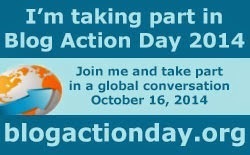
How can there be economic equality in a world where giant corporations control the world economy and 1% of the world's population control most of its wealth? How can there be gender or racial equality when most of that 1% are white males? How can there be equality in the biosphere when fossil fuel extractors are wealthier than any of the governments who might seek to control them in order to limit ecological damage?

These days you follow the money to find political power. Neo-liberalism - the economic philosophy so beloved of Margaret Thatcher and Ronald Reagan - has changed the world fundamentally and any attempts to curb its excesses are labelled as socialist threats. It was this philosophy that allowed the banking crisis to happen - and it wasn't the banks who paid for their costly errors, it was the ordinary people.
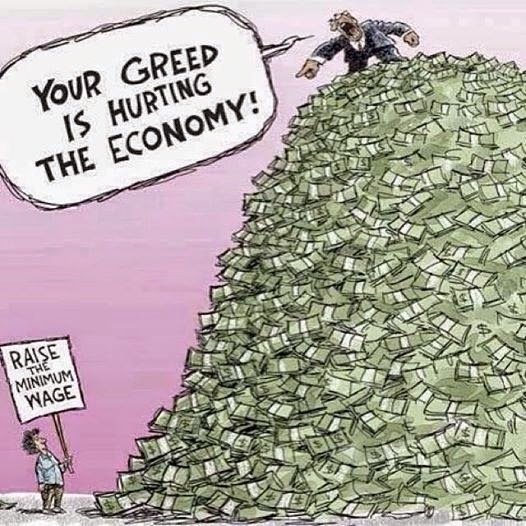
And it's not just the banks. Governments are in such thrall to the fossil fuel industry that attempts to persuade them to introduce measures to deal with climate change have so far been ineffective. Most of the military conflicts in the recent past have been driven by the need to control resources. It seems that the ordinary person in a supposedly democratic society has little power to change anything. We are in the world that Martin Luther King warned us of back in 1967.
"We as a nation must undergo a radical revolution of values. We must rapidly begin the shift from a 'thing-oriented society' to a 'person-oriented society'. When machines and computers, profit motives and property rights, are considered more important than people, the giant triplets of racism, extreme materialism, and militarism are incapable of being conquered." [Martin Luther King, 'Beyond Vietnam']
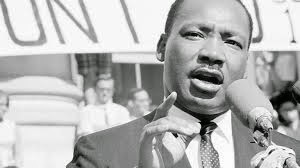
Our human rights and democratic freedoms are being steadily eroded in the pursuit of profit and ideological domination. Thanks to the 'War on Terror' we now have only limited rights to protest and we have lost our right to avoid imprisonment without trial, and judicial review of immigration issues. Whistle-blowers to government corruption and illegality are pursued as traitors.
Britain has its own Guantanamo . There are prisoners in jail under the terrorism legislation who have been there for more than 10 years but who have never been charged with any crime because no one could find any evidence to do so. They, or their lawyers, do not even have the right to be told why they are there. They are now so radicalised by the injustice that the government is afraid to release them.
And there are small children having to live without mothers or father because the government will not allow the spouses of British citizens, the parents of British children, into the country - a reaction to a frenzy of fear about immigration figures and electoral votes. They include a British teacher who went to teach in Moscow, married a Russian girl while he was there and had 2 children. When he tried to move back the UK he had to leave his wife behind at the airport.
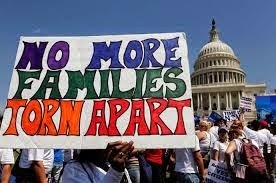
Another teacher married a woman in South Africa and found that when he returned to the UK he couldn't bring his wife back. A New Zealander who married a British man after living in England for 5 years, found that she was suddenly persona non grata when she applied for permanent leave to stay after her marriage.
My own daughter is bringing up 2 little girls on her own because her Cuban husband can't get a visa to live with them. Things are no better in the USA. Elizabeth Gilbert, the author of Eat, Pray, Love, who married an Australian passport holder, had to mount a year-long political campaign to get her husband (who owned a business in the US) allowed into the country.
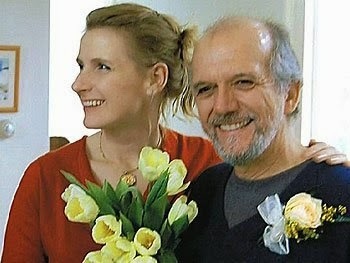
There is no longer any appeal process over immigration decisions, except to the European Court of Human Rights (a procedure that takes years). Habeas Corpus doesn't apply when the Terrorism (or immigration) legislation can be invoked and it is being used whenever and wherever convenient. The UK government is also discussing whether to opt out of the European Human Rights convention - a very worrying threat.
We are not all equal under the law, and moving away from a fair and just society at the speed of light. This is a terrible process to witness for someone who believes passionately in a fair society where resources such as health, education, housing, justice and the opportunity to work, are available to all.
We are facing a perfect storm of economic and climatic turbulence and we, the ordinary people, the 99%, need to reach out to each other and work together if we are to make a different kind of future for our children and grandchildren.
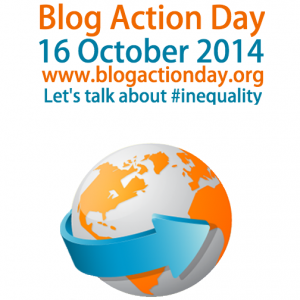
If you care, please share
Published on October 15, 2014 15:30
October 12, 2014
New Zealand - where the chickens eat ducklings!
I'm now in New Zealand and it's so different from my usual existence it feels as if I've arrived on a different planet - I'm surrounded by farmland on all sides and there are cows outside my bedroom window.

Outside the front door there are chickens (the cockerel attacks your ankles!)

and ducks

and they will come into the house if you don't shut the door firmly behind you.
We have two orphan ducklings in the bath

because mother Jemima decided that she'd had enough of motherhood and escaped from the pen this morning to waddle off with her tribe. Ducks are, apparently, very bad mothers. But Jemima's sister is sitting on a batch of eggs in the woodpile with great determination and hopefully they will have a better fate. Most of Jemima's ducklings were eaten by the chickens as they hatched from the eggs. Nature is very cruel!
 Peko on her eggs in the woodpile
Peko on her eggs in the woodpile
I am thoroughly over the jet-lag, thanks to my lovely daughter who organised a girlie weekend at Hanmer thermal springs - two days lying in hot water breathing sulphur would cure anything!


Outside the front door there are chickens (the cockerel attacks your ankles!)

and ducks

and they will come into the house if you don't shut the door firmly behind you.
We have two orphan ducklings in the bath

because mother Jemima decided that she'd had enough of motherhood and escaped from the pen this morning to waddle off with her tribe. Ducks are, apparently, very bad mothers. But Jemima's sister is sitting on a batch of eggs in the woodpile with great determination and hopefully they will have a better fate. Most of Jemima's ducklings were eaten by the chickens as they hatched from the eggs. Nature is very cruel!
 Peko on her eggs in the woodpile
Peko on her eggs in the woodpileI am thoroughly over the jet-lag, thanks to my lovely daughter who organised a girlie weekend at Hanmer thermal springs - two days lying in hot water breathing sulphur would cure anything!

Published on October 12, 2014 22:02



